Opal
| Opal | |
|---|---|
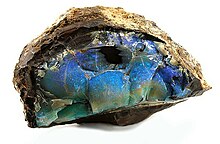 A rich seam of iridescent opal encased in matrix | |
| General | |
| Category | Mineraloid |
| Formula (repeating unit) | Hydratedsilica.SiO2·nH2O |
| IMA symbol | Opl[1] |
| Crystal system | Amorphous[2] |
| Identification | |
| Color | Colorless, white, yellow, red, orange, green, brown, black, blue, pink |
| Crystal habit | Irregular veins, in masses, in nodules |
| Cleavage | None[2] |
| Fracture | Conchoidalto uneven[2] |
| Mohs scalehardness | 5.5–6[2] |
| Luster | Subvitreous to waxy[2] |
| Streak | White |
| Diaphaneity | opaque, translucent, transparent |
| Specific gravity | 2.15+0.08 −0.90[2] |
| Density | 2.09 g/cm3 |
| Polish luster | Vitreous to resinous[2] |
| Optical properties | Single refractive, often anomalous double refractive due to strain[2] |
| Refractive index | 1.450+0.020 −0.080 Mexican opal may read as low as 1.37, but typically reads 1.42–1.43[2] |
| Birefringence | none[2] |
| Pleochroism | None[2] |
| Ultravioletfluorescence | black or white body color: inert to white to moderate light blue, green, or yellow in long and short wave, may also phosphoresce, common opal: inert to strong green or yellowish green in long and short wave, may phosphoresce; fire opal: inert to moderate greenish brown in long and short wave, may phosphoresce[2] |
| Absorption spectra | green stones: 660 nm, 470 nm cutoff[2] |
| Diagnostic features | darkening upon heating |
| Solubility | hotsalt water,bases,methanol,humic acid,hydrofluoric acid |
| References | [3][4] |

Opalis ahydratedamorphousform ofsilica(SiO2·nH2O); itswater contentmay range from 3% to 21% by weight, but is usually between 6% and 10%. Due to its amorphous property, it is classified as amineraloid,unlikecrystallineforms of silica, which are consideredminerals.It is deposited at a relatively low temperature and may occur in thefissuresof almost any kind ofrock,being most commonly found withlimonite,sandstone,rhyolite,marl,andbasalt.
The nameopalis believed to be derived from theSanskritwordupala(उपल), which means 'jewel', and later the Greek derivativeopállios(ὀπάλλιος).
There are two broad classes of opal: precious and common. Precious opal displays play-of-color (iridescence); common opal does not.[5]Play-of-color is defined as "a pseudo chromatic optical effect resulting in flashes of colored light from certain minerals, as they are turned in white light."[6]The internal structure of precious opal causes it todiffractlight, resulting in play-of-color. Depending on the conditions in which it formed, opal may be transparent, translucent, or opaque, and the background color may be white, black, or nearly any color of the visual spectrum. Black opal is considered the rarest, while white, gray, and green opals are the most common.
Precious opal[edit]
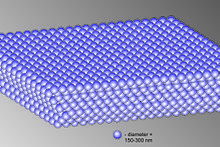
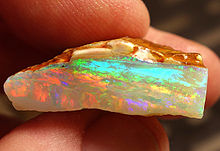
Precious opal shows a variable interplay of internal colors, and though it is a mineraloid, it has an internal structure. At microscopic scales, precious opal is composed of silica spheres some 150–300 nm (5.9×10−6–1.18×10−5in) in diameter in a hexagonal or cubicclose-packedlattice.It was shown by J. V. Sanders in the mid-1960s[7][8]that these ordered silica spheres produce the internal colors by causing theinterferenceanddiffractionof light passing through the microstructure of the opal.[9]The regularity of the sizes and the packing of these spheres is a prime determinant of the quality of precious opal. Where the distance between the regularly packed planes of spheres is around half the wavelength of a component ofvisible light,the light of that wavelength may be subject to diffraction from thegratingcreated by the stacked planes. The colors that are observed are determined by the spacing between the planes and the orientation of planes with respect to the incident light. The process can be described byBragg's lawof diffraction.
Visible light cannot pass through large thicknesses of the opal. This is the basis of the opticalband gapin aphotonic crystal.The notion that opals are photonic crystals for visible light was expressed in 1995 byVasily Astratov's group.[10]In addition, microfractures may be filled with secondary silica and form thinlamellaeinside the opal during its formation. The termopalescenceis commonly used to describe this unique and beautiful phenomenon, which in gemology is termedplay of color.In gemology, opalescence is applied to the hazy-milky-turbidsheen of common or potch opal which does not show a play of color.[clarification needed]Opalescence is a form ofadularescence.
For gemstone use, most opal is cut and polished to form acabochon."Natural" opal refers to polished stones consisting wholly of precious opal. Opals too thin to produce a "natural" opal may be combined with other materials to form "composite" gems. An opaldoubletconsists of a relatively thin layer of precious opal, backed by a layer of dark-colored material, most commonly ironstone, dark or black common opal (potch), onyx, or obsidian. The darker backing emphasizes the play of color and results in a more attractive display than a lighter potch. An opal triplet is similar to a doublet but has a third layer, a domed cap of clearquartzor plastic on the top. The cap takes a high polish and acts as a protective layer for the opal. The top layer also acts as a magnifier, to emphasize the play of color of the opal beneath, which is often an inferior specimen or an extremely thin section of precious opal. Triplet opals tend to have a more artificial appearance and are not classed as precious gemstones, but rather "composite" gemstones. Jewelry applications of precious opal can be somewhat limited by opal's sensitivity to heat due primarily to its relatively high water content and predisposition to scratching.[11]Combined with modern techniques of polishing, a doublet opal can produce a similar effect to Natural black or boulder opal at a fraction of the price. Doublet opal also has the added benefit of having genuine opal as the top visible and touchable layer, unlike triplet opals.
Common opal[edit]
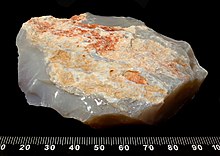

Besides thegemstonevarieties that show a play of color, the other kinds of common opal include the milk opal, milky bluish to greenish (which can sometimes be of gemstone quality);resinopal, which is honey-yellow with a resinous luster; wood opal, which is caused by the replacement of the organic material in wood with opal;[12]menilite,which is brown or grey;hyalite,a colorless glass-clear opal sometimes called Muller's glass;geyserite,also calledsiliceous sinter,deposited aroundhot springsorgeysers;anddiatomaceous earth,the accumulations ofdiatomshells or tests. Common opal often displays a hazy-milky-turbidsheen from within the stone. Ingemology,this optical effect is strictly defined as opalescence which is a form of adularescence.
Varieties of common opal[edit]

"Girasol opal" is a term sometimes mistakenly and improperly used to refer to fire opals, as well as a type of transparent to semitransparent type milky quartz from Madagascar which displays an asterism, or star effect when cut properly. However, the true girasol opal[14]is a type ofhyaliteopal that exhibits a bluish glow or sheen that follows the light source around. It is not a play of color as seen in precious opal, but rather an effect from microscopic inclusions. It is also sometimes referred to as water opal, too, when it is from Mexico. The two most notable locations of this type of opal areOregonand Mexico.[15]
A Peruvian opal (also called blue opal) is a semi-opaque to opaque blue-green stone found in Peru, which is often cut to include the matrix in the more opaque stones. It does not display a play of color. Blue opal also comes fromOregonand Idaho in theOwyheeregion, as well as fromNevadaaround theVirgin Valley.[16]
Opal is also formed bydiatoms.Diatoms are a form of algae that, when they die, often form layers at the bottoms of lakes, bays, or oceans. Their cell walls are made up of hydrated silicon dioxide which gives themstructural colorationand therefore the appearance of tiny opals when viewed under a microscope. These cell walls or "tests" form the “grains” for thediatomaceous earth.This sedimentary rock is white, opaque, and chalky in texture.[17]Diatomite has multiple industrial uses such as filtering or adsorbing since it has a fine particle size and very porous nature, and gardening to increase water absorption.
History[edit]
Opal was rare and very valuable in antiquity. In Europe, it was a gem prized by royalty.[18][19]Until the opening of vast deposits in Australia in the 19th century the only known source wasČervenicabeyond the Roman frontier inSlovakia.[20]Opal is the nationalgemstoneof Australia.[21]
Sources[edit]
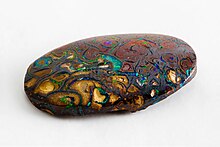
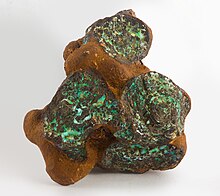
The primary sources of opal are Australia and Ethiopia, but because of inconsistent and widely varying accountings of their respective levels of extraction, it is difficult to accurately state what proportion of the global supply of opal comes from either country. Australian opal has been cited as accounting for 95–97% of the world's supply of precious opal,[23][24]with the state ofSouth Australiaaccounting for 80% of the world's supply.[25]In 2012, Ethiopian opal production was estimated to be 14,000 kg (31,000 lb) by the United States Geological Survey.[26]USGSdata from the same period (2012), reveals Australian opal production to be $41 million.[27]Because of the units of measurement, it is not possible to directly compare Australian and Ethiopian opal production, but these data and others suggest that the traditional percentages given for Australian opal production may be overstated.[28]Yet, the validity of data in the USGS report appears to conflict with that of Laurs et al.[citation needed]and Mesfin,[citation needed]who estimated the 2012 Ethiopian opal output (fromWegeltena) to be only 750 kg (1,650 lb).
Australia[edit]
The town ofCoober PedyinSouth Australiais a major source of opal. The world's largest and most valuable gem opal "Olympic Australis"was found in August 1956 at the" Eight Mile "opal field in Coober Pedy. It weighs 17,000 carats (3.4 kg; 7.5 lb) and is 11 inches (280 mm) long, with a height of4+3⁄4in (120 mm) and a width of4+1⁄2in (110 mm).[29]
TheMintabie Opal Fieldin South Australia located about 250 km (160 mi) northwest of Coober Pedy has also produced large quantities of crystal opal and the rarer black opal. Over the years, it has been sold overseas incorrectly as Coober Pedy opal. The black opal is said to be some of the best examples found in Australia.
Andamookain South Australia is also a major producer of matrix opal, crystal opal, and black opal. Another Australian town,Lightning RidgeinNew South Wales,is the main source of black opal, opal containing a predominantly dark background (dark gray to blue-black displaying the play of color), collected from theGriman Creek Formation.[30]Boulder opal consists ofconcretionsand fracture fillings in a dark siliceousironstonematrix. It is found sporadically in western Queensland, from Kynuna in the north, toYowahandKoroitin the south.[31]Its largest quantities are found aroundJundahandQuilpieinSouth West Queensland.Australia also has opalizedfossilremains, including dinosaur bones in New South Wales[32]and South Australia,[33]and marine creatures in South Australia.[34]
Ethiopia[edit]
It has been reported that Northern African opal was used to make tools as early as 4000 BC.[citation needed]The first published report of gem opal fromEthiopiaappeared in 1994, with the discovery of precious opal in the Menz Gishe District, North Shewa Province.[35]The opal, found mostly in the form of nodules, was of volcanic origin and was found predominantly within weathered layers ofrhyolite.[36]This Shewa Province opal was mostly dark brown in color and had a tendency to crack. These qualities made it unpopular in the gem trade. In 2008, a new opal deposit was found approximately 180 km north of Shewa Province, near the town ofWegeltena,in Ethiopia'sWollo Province.The Wollo Province opal was different from the previous Ethiopian opal finds in that it more closely resembled the sedimentary opals of Australia and Brazil, with a light background and often vivid play-of-color.[37]Wollo Province opal, more commonly referred to as "Welo" or "Wello" opal, has become the dominant Ethiopian opal in the gem trade.[38]

Virgin Valley, Nevada[edit]

The Virgin Valley[39]opal fields ofHumboldt Countyin northernNevadaproduce a wide variety of precious black, crystal, white, fire, and lemon opal. The black fire opal is the official gemstone of Nevada. Most of the precious opal is partial wood replacement. The precious opal is hosted and foundin situwithin a subsurface horizon or zone ofbentonite,which is considered a "lode" deposit. Opals which have weathered out of thein situdeposits are alluvial and consideredplacer deposits.Miocene-age opalised teeth, bones, fish, and a snake head have been found. Some of the opal has high water content and may desiccate and crack when dried. The largest producing mines of Virgin Valley have been the famous Rainbow Ridge,[40]Royal Peacock,[41]Bonanza,[42]Opal Queen,[43]and WRT Stonetree/Black Beauty[44]mines. The largest unpolished black opal in the Smithsonian Institution, known as the "Roebling opal",[45]came out of the tunneled portion of the Rainbow Ridge Mine in 1917, and weighs 2,585 carats (517.0 g; 18.24 oz). The largest polished black opal in theSmithsonian Institutioncomes from the Royal Peacock opal mine in the Virgin Valley, weighing 160 carats (32 g; 1.1 oz), known as the "Black Peacock".[46]
Mexico[edit]
Fire opal is a transparent to translucent opal with warm body colors of yellow to orange to red. Although fire opals don't usually show any play of color, they occasionally exhibit bright green flashes. The most famous source of fire opals is the state ofQuerétaroin Mexico; these opals are commonly called Mexican fire opals.[47]Fire opals that do not show a play of color are sometimes referred to as jelly opals. Mexican opals are sometimes cut in their rhyolitic host material if it is hard enough to allow cutting and polishing. This type of Mexican opal is referred to as a Cantera opal. Another type of opal from Mexico, referred to as Mexican water opal, is a colorless opal that exhibits either a bluish or golden internal sheen.[14]

Opal occurs in significant quantity and variety in central Mexico, whereminingand production first originated in the state ofQuerétaro.In this region the opal deposits are located mainly in the mountain ranges of three municipalities:Colón,Tequisquiapan,andEzequiel Montes.During the 1960s through to the mid-1970s, the Querétaro mines were heavily mined. Today's opal miners report that it was much easier to find quality opals with a lot of fire and play of color back then, whereas today the gem-quality opals are very hard to come by and command hundreds of US dollars or more. The orange-red background color is characteristic of all "fire opals," including "Mexican fire opal".
The oldest mine in Querétaro is Santa Maria del Iris. This mine was opened around 1870 and has been reopened at least 28 times since. At the moment there are about 100 mines in the regions around Querétaro, but most of them are now closed. The best quality of opals came from the mine Santa Maria del Iris, followed by La Hacienda la Esperanza, Fuentezuelas, La Carbonera, and La Trinidad. Important deposits in the state ofJaliscowere not discovered until the late 1950s.
In 1957, Alfonso Ramirez (of Querétaro) accidentally discovered the first opal mine in Jalisco: La Unica, located on the outer area of the volcano of Tequila, near the Huitzicilapan farm inMagdalena.By 1960 there were around 500 known opal mines in this region alone. Other regions of the country that also produce opals (of lesser quality) areGuerrero,which produces an opaque opal similar to the opals from Australia (some of these opals are carefully treated with heat to improve their colors so high-quality opals from this area may be suspect). There are also some small opal mines inMorelos,Durango,Chihuahua,Baja California,Guanajuato,Puebla,Michoacán,andEstado de México.
Other locations[edit]
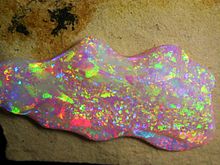
Another source of white base opal or creamy opal in the United States isSpencer, Idaho.[48]A high percentage of the opal found there occurs in thin layers.
Other significant deposits of precious opal around the world can be found in the Czech Republic, Canada, Slovakia, Hungary, Turkey, Indonesia, Brazil (inPedro II, Piauí[49]), Honduras (more precisely inErandique), Guatemala, and Nicaragua.
In late 2008,NASAannounced the discovery of opal deposits onMars.[50]
Fossil opal[edit]


Wood opal,also known asxylopal,[51][52]is a form of opal,[53]as well as a type ofpetrified woodwhich has developed an opalescent sheen or, more rarely, where the wood has been completely replaced by opal. Other names for this opalized sheen-like wood areopalized woodandopalized petrified wood.It is often used as agemstone.[54]
Synthetic opal[edit]

Opals of all varieties have been synthesized experimentally and commercially. The discovery of the ordered sphere structure of precious opal led to its synthesis by Pierre Gilson in 1974.[9]The resulting material is distinguishable from natural opal by its regularity; under magnification, the patches of color are seen to be arranged in a "lizard skin" or "chicken wire" pattern. Furthermore, synthetic opals do notfluoresceunderultravioletlight. Synthetics are also generally lower in density and are often highly porous.
Opals which have been created in a laboratory are often termed "lab-created opals", which, while classifiable as man-made and synthetic, are very different from their resin-based counterparts which are also considered man-made and synthetic. The term "synthetic" implies that a stone has been created to be chemically and structurally indistinguishable from a genuine one, and genuine opal contains no resins or polymers. The finest modern lab-created opals do not exhibit the lizard skin or columnar patterning of earlier lab-created varieties, and their patterns are non-directional. They can still be distinguished from genuine opals, however, by their lack ofinclusionsand the absence of any surrounding non-opalmatrix.While many genuine opals are cut and polished without a matrix, the presence of irregularities in their play-of-color continues to mark them as distinct from even the best lab-created synthetics.
Other research in macroporous structures have yielded highly ordered materials that have similar optical properties to opals and have been used in cosmetics.[55]Synthetic opals are also deeply investigated inphotonicsfor sensing and light management purposes.[56][57]
Local atomic structure[edit]


The lattice of spheres of opal that cause interference with light is several hundred times larger than the fundamental structure of crystalline silica. As amineraloid,nounit celldescribes the structure of opal. Nevertheless, opals can be roughly divided into those that show no signs of crystalline order (amorphousopal) and those that show signs of the beginning of crystalline order, commonly termedcryptocrystallineor microcrystalline opal.[58]Dehydration experiments andinfrared spectroscopyhave shown that most of the H2O in the formula of SiO2·nH2O of opals is present in the familiar form of clusters of molecular water. Isolated water molecules, andsilanols,structures such as SiOH, generally form a lesser proportion of the total and can reside near the surface or in defects inside the opal.
The structure of low-pressurepolymorphsof anhydroussilicaconsists of frameworks of fully corner bonded tetrahedra of SiO4.The higher temperature polymorphs of silicacristobaliteandtridymiteare frequently the first to crystallize from amorphous anhydrous silica, and the local structures of microcrystalline opals also appear to be closer to that of cristobalite and tridymite than to quartz. The structures of tridymite and cristobalite are closely related and can be described ashexagonalandcubic close-packedlayers. It is therefore possible to have intermediate structures in which the layers are not regularly stacked.
Microcrystalline opal[edit]
Microcrystalline opal orOpal-CThas been interpreted as consisting of clusters of stackedcristobaliteandtridymiteover very short length scales. The spheres of opal in microcrystalline opal are themselves made up of tiny nanocrystalline blades of cristobalite and tridymite. Microcrystalline opal has occasionally been further subdivided in the literature. Water content may be as high as 10 wt%.[59]Opal-CT, also calledlussatineorlussatite,is interpreted as consisting of localized order of α-cristobalite with a lot of stacking disorder. Typical water content is about 1.5 wt%.
Noncrystalline opal[edit]

Two broad categories of noncrystalline opals, sometimes just referred to as "opal-A" ( "A" stands for "amorphous" ),[60]have been proposed. The first of these is opal-AG consisting of aggregated spheres of silica, with water filling the space in between. Precious opal and potch opal are generally varieties of this, the difference being in the regularity of the sizes of the spheres and their packing. The second "opal-A" is opal-AN or water-containing amorphous silica-glass.Hyaliteis another name for this.
Noncrystalline silica in siliceous sediments is reported to gradually transform to opal-CT and then opal-C as a result ofdiagenesis,due to the increasing overburden pressure insedimentaryrocks, as some of the stacking disorder is removed.[61]
Opal surface chemical groups[edit]
The surface of opal in contact with water is covered bysiloxanebonds (≡Si–O–Si≡) andsilanolgroups (≡Si–OH). This makes the opal surface veryhydrophilicand capable of forming numeroushydrogen bonds.
Etymology[edit]
The word 'opal' is adapted from theLatintermopalus.The origin of this word in turn is a matter of debate, but most modern references suggest it is adapted from theSanskritwordúpalameaning ‘precious stone’.[62]
As references to the gem are made byPliny the Elder,one theory attributed the name's origin to Roman mythology: to have been adapted fromOps,the wife ofSaturn,and goddess of fertility. (The portion ofSaturnaliadevoted to Ops was "Opalia", similar toopalus.)
Another common claim was that the term was adapted from theAncient Greekword,opallios.This word has two meanings, one is related to "seeing" and forms the basis of the English words like "opaque"; the other is "other" as in "alias" and "alter". It is claimed thatopaluscombined these uses, meaning "to see a change in color". However, historians have noted the first appearances ofopalliosdo not occur until after the Romans had taken over the Greek states in 180 BC and they had previously used the termpaederos.[62]
However, the argument for the Sanskrit origin is strong. The term first appears in Roman references around 250 BC, at a time when the opal was valued above all other gems. The opals were supplied by traders from theBosporus,who claimed the gems were being supplied from India. Before this, the stone was referred to by a variety of names, but these fell from use after 250 BC.
Historical superstitions[edit]
In the Middle Ages, opal was considered a stone that could provide great luck because it was believed to possess all the virtues of each gemstone whose color was represented in the color spectrum of the opal.[63]It was also said to grant invisibility if wrapped in a freshbay leafand held in the hand.[63][64]As a result, the opal was seen as the patron gemstone forthievesduring themedieval period.[65]Following the publication of SirWalter Scott'sAnne of Geiersteinin 1829, opal acquired a less auspicious reputation. In Scott's novel, the Baroness of Arnheim wears an opaltalismanwith supernatural powers. When a drop ofholy waterfalls on the talisman, the opal turns into a colorless stone and the Baroness dies soon thereafter. Due to the popularity of Scott's novel, people began to associate opals with bad luck and death.[63]Within a year of the publishing of Scott's novel in April 1829, the sale of opals in Europe dropped by 50%, and remained low for the next 20 years or so.[66]
Even as recently as the beginning of the 20th century, it was believed that when a Russian saw an opal among other goods offered for sale, he or she should not buy anything more, as the opal was believed to embody theevil eye.[63]
Opal is considered thebirthstonefor people born in October.[67]
Examples[edit]
- TheOlympic Australis,the world's largest and most valuable gem opal, found inCoober Pedy[68]
- TheAndamooka Opal,presented toQueen Elizabeth II,also known as the Queen's Opal
- TheAddyman Plesiosaurfrom Andamooka, "the finest known opalised skeleton on Earth"[34]
- The Burning of Troy, the now-lost opal presented toJoséphine de BeauharnaisbyNapoleon I of Franceand the first named opal[69]
- TheFlame Queen Opal
- Opal cameo (jewellery-case) of a profile head of a helmeted warrior, attributed to Wilhelm Schmidt[70]
- TheHalley's Comet Opal,the world's largest uncut black opal
- Although the clock faces above the information stand inGrand Central Terminalin New York City are often said to be opal, they are in factopalescent glass
- The Roebling Opal, Smithsonian Institution[71]
- TheGalaxy Opal,listed as the "World's Largest Polished Opal" in the 1992 Guinness Book of Records[72]
- The Rainbow Virgin, "the finest crystal opal specimen ever unearthed"[73][74][75]
- The Sea of Opal, the largest black opal in the world[76]
- TheFire of Australia,assumed to be "the finest uncut opal in existence"[75][77]
- Beverly the Bug,the first known example of an opal with an insectinclusion
See also[edit]
- Biogenic silica
- Cacholong– variety of opal
- Foil opal– metal foil sometimes used to create reflection and sparkle behind milky glass or quartz faces in costume jewelry simulating real opal
- Labradorite
- Opalite– Trade name for opal and moonstone simulants
- Optical phenomena– Observable events that result from the interaction of light and matter
- Uncut Gems(2019 film)
References[edit]
- ^Warr, L.N. (2021)."IMA–CNMNC approved mineral symbols".Mineralogical Magazine.85(3): 291–320.Bibcode:2021MinM...85..291W.doi:10.1180/mgm.2021.43.S2CID235729616.
- ^abcdefghijklmGemological Institute of America,GIA Gem Reference Guide1995,ISBN0-87311-019-6
- ^"Opal".Webmineral.Archivedfrom the original on 18 October 2011.Retrieved8 October2011.
- ^"Opal".Mindat.org.Archivedfrom the original on 6 October 2011.Retrieved8 October2011.
- ^"Opal Description".Gemological Institute of America.Retrieved4 June2018.
- ^"Glossary: Play of Color".Mindat.Retrieved4 June2018.
- ^Sanders, J. V. (1964). "Colour of precious opal".Nature.204(496): 1151–1153.Bibcode:1964Natur.204.1151S.doi:10.1038/2041151a0.S2CID4169953.
- ^Sanders, J. V. (1968). "Diffraction of light by opals".Acta Crystallographica A.24(4): 427–434.Bibcode:1968AcCrA..24..427S.doi:10.1107/S0567739468000860.
- ^abKlein, Cornelis; Hurlbut, Cornelius S. (1985).Manual of Mineralogy(20th ed.). Wiley.ISBN978-0-471-80580-9.
- ^Astratov, V. N.; Bogomolov, V. N.; Kaplyanskii, A. A.; Prokofiev, A. V.; Samoilovich, L. A.; Samoilovich, S. M.; Vlasov, Yu. A. (1995). "Optical spectroscopy of opal matrices with CdS embedded in its pores: Quantum confinement and photonic band gap effects".Il Nuovo Cimento D.17(11–12): 1349–1354.Bibcode:1995NCimD..17.1349A.doi:10.1007/bf02457208.S2CID121167426.
- ^Dr. Joel Arem; Donald Clark, CSM IMG (23 June 2015)."Opal Value, Price, and Jewelry".Gemsociety.org.Archivedfrom the original on 23 November 2016.Retrieved22 November2016.
- ^Gribble, C. D. (1988). "Tektosilicates (framework silicates)".Rutley's Elements of Mineralogy(27th ed.). London: Unwin Hyman. p. 431.ISBN978-0-04-549011-0.
- ^Downing, Paul B. (1992).Opal Identification and Value.pp. 55–61.
- ^abSwisher, James; Anthony, Edna B."Let's Talk Gemstones: Opal".Archivedfrom the original on 7 November 2011.
- ^Page, Geology (21 June 2016)."Types of Opal".Geology Page.Retrieved29 December2022.
- ^"Opal – Nevada Mining Association".www.nevadamining.org.19 December 2017.Retrieved18 June2020.
- ^"diatomite – The Mineral and Gemstone Kingdom".www.minerals.net.Retrieved15 May2018.
- ^"The central stone on the thirteenth-century crown of the Holy Roman Emperor was an opal said to be the color of pure white snow, sparkling with splashes of bright red wine: it was called" the Orphanus ", perhaps because there was no other stone like it.24 And on New Year's Day 1584,25 Queen Elizabeth I was delighted to receive an opal parure—a full set of matching jewelry—from one of her favorite courtiers, Sir Christopher Hatton." Finlay, Victoria. Jewels: A Secret History (Kindle Locations 2145–2148). Random House Publishing Group. Kindle Edition.
- ^"All of these early stones were almost certainly from the ancient mines of Slovakia—the same source as Nonius’ precious stone and the Holy Roman Emperor’s red-and-white one. The mines were worked until the late nineteenth century..." Finlay, Victoria. Jewels: A Secret History (Kindle Locations 2163–2165). Random House Publishing Group. Kindle Edition.
- ^Finlay, Victoria. Jewels: A Secret History (Kindle Location 1871). Random House Publishing Group. Kindle Edition.
- ^"Australian National Gemstone".Australian Government, Department of the Prime Minister and Cabinet.Retrieved10 June2018.
- ^"Yowah Nut: Yowah Nut mineral information and data".Mindat.org.20 February 2011.Archivedfrom the original on 12 May 2011.Retrieved8 March2011.
- ^"Ethiopian opal Gemstone".Cabochons for Sale.Australian Government.Archivedfrom the original on 29 January 2011.
- ^"Rapaport Magazine – A Designer Stone".Archivedfrom the original on 6 October 2014.
- ^"Opal – South Australia's Gemstone".Government of South Australia. Archived fromthe originalon 16 July 2012.Retrieved11 July2012.
- ^Yager, Thomas R. (1 December 2013), "The Mineral Industry of Ethiopia",United States Geological Survey, 2012 Minerals Yearbook(PDF),pp. 17.1–17.5,archived(PDF)from the original on 6 October 2014
- ^Tse, Pui-Kwan (1 December 2013), "The Mineral Industry of Australia",United States Geological Survey, 2012 Minerals Yearbook(PDF),pp. 3.1–3.27,archived(PDF)from the original on 6 October 2014,retrieved20 September2014
- ^"Rapaport Magazine – Ethiopian Opal".Archivedfrom the original on 6 October 2014.
- ^Cram, Len (2006).A history of South Australian opal, 1840–2005.Lightning Ridge, NSW.ISBN978-0975721407.
{{cite book}}:CS1 maint: location missing publisher (link) - ^Osborne, Zoe; Kitanov, Alex (17 July 2022)."The black-opal hunters of outback Australia".Al Jazeera.Retrieved8 August2022.
- ^"Queensland opal".Archived fromthe originalon 13 October 2007.
- ^First dinosaur named in NSW in nearly a century after chance discoveryABC News,5 December 2018. Retrieved 5 December 2018.
- ^Rare dinosaur fossil discovered on internet after disappearing for decadesABC News,3 December 2018. Retrieved 3 December 2018.
- ^ab"Opal Fossils".South Australian Museum.Archivedfrom the original on 13 February 2014.Retrieved3 March2014.
- ^Barot, N. (1994). "New precious opal deposit found in Ethiopia".ICA Gazette.
- ^Johnson, Mary L.; Kammerling, Robert C.; DeGhionno, Dino G.; Koivula, John I. (Summer 1996)."Opal from Shewa Province, Ethiopia".Gems & Gemology.32(2): 112–120.doi:10.5741/GEMS.32.2.112.
- ^Rondeau, Benjamin (Summer 2010)."Play-of-color from Wegeltena, Wollo Province, Ethiopia".Gems & Gemology.doi:10.5741/GEMS.46.2.90.
- ^Gashaw, Yidneka (8 April 2012)."Opal Trade Transforms North Wollo".Addis Fortune.Archivedfrom the original on 24 September 2014.
- ^"Virgin Valley District, Humboldt Co., Nevada".mindat.org.Archivedfrom the original on 30 April 2012.
- ^"Rainbow Ridge Mine".mindat.org.Archivedfrom the original on 30 April 2012.
- ^"Royal Peacock Group Mines, Virgin Valley District, Humboldt Co., Nevada".mindat.org.Archivedfrom the original on 30 April 2012.
- ^"Bonanza Opal Workings (Virgin Opal), Virgin Valley District, Humboldt Co., Nevada".mindat.org.Archivedfrom the original on 30 April 2012.
- ^"Opal Queen group, Virgin Valley District, Humboldt Co., Nevada".mindat.org.Archivedfrom the original on 30 April 2012.
- ^"Stonetree Opal Mine, WRT Stonetree group, Virgin Valley District, Humboldt Co., Nevada".mindat.org.Archivedfrom the original on 30 April 2012.
- ^"Roebling Opal".National Museum of Natural History. Archived fromthe originalon 7 November 2012.
- ^"Opal".Lapidary Journal:1522, 1542. March 1971.
- ^Koivula, John (1983)."Opal from Querétaro, Mexico: Occurrence and Inclusions".Gems & Gemology.19(2): 87–96.doi:10.5741/GEMS.19.2.87.
- ^"If you've ever wanted an opal – it's time to visit Spencer | East Idaho News".East Idaho News.6 August 2015.Retrieved14 February2018.
- ^"Boi Morto Mine, Pedro II, Piauí, Brazil".Mindat.org.Archivedfrom the original on 12 May 2011.Retrieved8 October2011.
- ^"NASA probe finds opals in Martian crevices".Jet Propulsion Laboratory.Archivedfrom the original on 19 January 2009.Retrieved29 October2008.
- ^"Xylopal".mindat.org.Retrieved6 June2023.
- ^"Wood Opal - mindat.org".mindat.org.Retrieved6 June2023.
- ^Egleston, T. (1887).Catalogue of minerals and synonyms.Washington: Gov. Print. Off. p. 238.OCLC918261679.Retrieved10 July2023.
- ^"Opalised Wood".geology.com.Retrieved6 June2023.
- ^"Macroporous Structures, Metal Oxides, Highly Ordered".Office for Technology Commercialization, Technology Marketing Site.University of Minnesota. 25 June 2010.Archivedfrom the original on 24 March 2012.Retrieved8 October2011.
- ^Lova, Paola; Congiu, Simone; Sparnacci, Katia; Angelini, Angelo; Boarino, Luca; Laus, Michele; Stasio, Francesco Di; Comoretto, Davide (8 April 2020)."Core–shell silica–rhodamine B nanosphere for synthetic opals: from fluorescence spectral redistribution to sensing".RSC Advances.10(25): 14958–14964.Bibcode:2020RSCAd..1014958L.doi:10.1039/D0RA02245D.ISSN2046-2069.PMC9052040.PMID35497145.
- ^Tétreault, N.; Míguez, H.; Ozin, G. A. (2004). "Silicon Inverse Opal—A Platform for Photonic Bandgap Research".Advanced Materials.16(16): 1471–1476.Bibcode:2004AdM....16.1471T.doi:10.1002/adma.200400618.ISSN1521-4095.S2CID137194866.
- ^Graetsch, H. (1994). Heaney, P. J.; Prewitt, Connecticut; Gibbs, G. V. (eds.). "Structural characteristics of opaline and microcrystalline silica minerals. Silica, physical behavior, geochemistry and materials applications".Reviews in Mineralogy.29.
- ^Opal-CT on Midat
- ^Wilson, M.J. (2014)."The structure of opal-CT revisited".Journal of Non-Crystalline Solids.405:68.Bibcode:2014JNCS..405...68W.doi:10.1016/j.jnoncrysol.2014.08.052.Retrieved16 June2022.
- ^Cady, S. L.; Wenk, H.-R.; Downing, K. H. (1996)."HRTEM of microcrystalline opal in chert and porcelanite from the Monterey Formation, California"(PDF).American Mineralogist.81(11–12): 1380–1395.Bibcode:1996AmMin..81.1380C.doi:10.2138/am-1996-11-1211.S2CID53527412.Archived(PDF)from the original on 1 October 2011.
- ^abEckert, Allan W.(1997).The World of Opals.John Wiley and Sons. pp. 56–57.ISBN9780471133971.Archivedfrom the original on 26 April 2016.
- ^abcdFernie, William Thomas (1907).Precious Stones for Curative Wear.Bristol: John Wright & Co. pp.248–249.
- ^Dunwich, Gerina(1996).Wicca Candle Magick.pp. 84–85.
- ^"Opal Symbolism and Legends".International Gem Society.Retrieved16 October2022.
- ^Eckert, Allan W.(1997). "A Chronological History and Mythology of Opals".The World of Opals.New York: John Wiley & Sons. pp. 53–118.
- ^Goldberg-Gist, Arlene (2003)."What's that Stuff? Opal".Chemical & Engineering News.81(4).doi:10.1021/cen-v081n004.p058.
- ^Leechman, F;The opal book,University of California Press, 1961
- ^Eckert, Allan W.(1997).The World of Opals.Chichester: John Wiley & Sons. pp. 67, 126.ISBN978-0-471-13397-1.
- ^"cameo; jewellery-case".The British Museum.Retrieved7 January2024.
- ^"The Dynamic Earth".National Museum of Natural History. Archived fromthe originalon 7 June 2011.Retrieved8 October2011.
- ^Guinness, Medd (October 1992)."The Guinness Book of Records 1993.Guinness. p. 22.ISBN978-0-85112-978-5.Archivedfrom the original on 26 August 2016.
- ^"Million-dollar opal Rainbow Virgin to go on display at SA exhibition celebrating centenary".ABC News.2 August 2015.Archivedfrom the original on 17 December 2017.Retrieved13 January2016.
- ^"Opals media releases".South Australian Museum.Archivedfrom the original on 29 December 2015.Retrieved13 January2016.
- ^ab"$4 million worth of the South Australian Museum's opal collection for display in Qatar".South Australian Museum.Archivedfrom the original on 17 December 2017.Retrieved7 July2017.
- ^"Largest black opal in the world".25 October 2016.Archivedfrom the original on 19 March 2017.Retrieved18 March2017.
- ^"World's finest piece of uncut opal finds new home at the South Australian Museum".South Australian Museum.Archivedfrom the original on 26 June 2017.Retrieved7 July2017.
Further reading[edit]
- Eckert, Alan(1997).The World of Opals.Wiley.ISBN9780471133971.OCLC36352362.
External links[edit]
- Farlang opal Hist. ReferencesLocalities, anecdotes byTheophrastus,Isaac Newton,Georg Agricolaetc.
- ICA's Opal Page:International Colored Stone Association
- Opal Fossils from the South Australian MuseumArchived13 February 2014 at theWayback MachineAccessed 19 October 2016.
- Opal Mineral data and specimen imagesMineralogy Database
- OpalworldAustralian Opal Fields – Map of precious opal deposits
